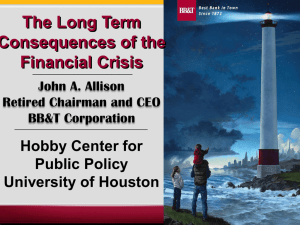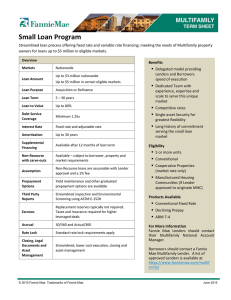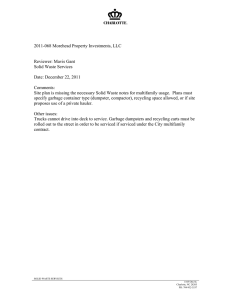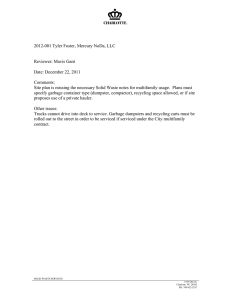The GSEs’ Shrinking Role in the Multifamily Market April 2015
advertisement
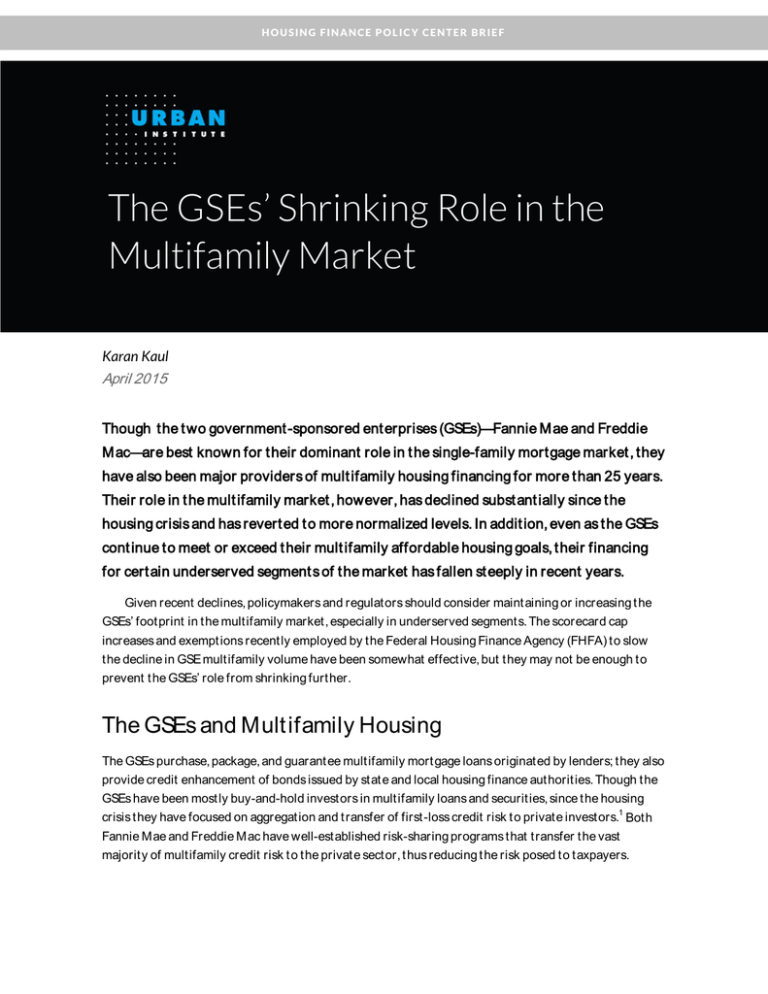
HOUSING FINANCE POLICY CENTER BRIEF The GSEs’ Shrinking Role in the Multifamily Market Karan Kaul April 2015 Though the t wo government -sponsored ent erprises (GSEs)—Fannie Mae and Freddie Mac—are best known for t heir dominant role in t he single-family mortgage market , they have also been major providers of mult ifamily housing financing for more t han 25 years. Their role in t he mult ifamily market , however, has declined subst ant ially since the housing crisis and has revert ed t o more normalized levels. In addit ion, even as t he GSEs cont inue to meet or exceed t heir mult ifamily affordable housing goals, t heir financing for cert ain underserved segment s of t he market has fallen st eeply in recent years. Given recent declines, policymakers and regulators should consider maintaining or increasing t he GSEs’ footprint in the multifamily market, especially in underserved segments. The scorecard cap increases and exempt ions recently employed by the Federal Housing Finance Agency (FHFA) to slow the decline in GSE multifamily volume have been somewhat effect ive, but they may not be enough to prevent t he GSEs’ role from shrinking further. The GSEs and Multifamily Housing The GSEs purchase, package, and guarant ee multifamily mort gage loans originated by lenders; they also provide credit enhancement of bonds issued by stat e and local housing finance authorit ies. Though the GSEs have been most ly buy-and-hold investors in multifamily loans and securities, since the housing 1 crisis they have focused on aggregation and t ransfer of first-loss credit risk t o private investors. Both Fannie Mae and Freddie Mac have well-established risk-sharing programs that transfer the vast majority of multifamily credit risk t o the privat e sector, t hus reducing t he risk posed to taxpayers. Freddie Mac shares multifamily credit risk wit h capital market investors t hrough securit izat ion, while Fannie Mae relies more on loan-level risk sharing wit h lenders. The GSEs provide financing for various multifamily propert ies ranging from t raditional apart ments to rental housing t argeted specifically at economically disadvantaged, underserved, and hard-to-serve 2 communit ies. GSE multifamily loan programs can be roughly classified into t hree cat egories: 1. General purpose mult ifamily—financing for general purpose rental properties such as traditional apartments. 2. Special purpose multifamily—financing for purpose-built propert ies, or loans that require nonst andard underwrit ing, such as senior housing—properties that include skilled nursing, independent living, or assisted student housing—apartment complexes built exclusively for students, located near major living facilities; colleges and universities; manufactured housing community loans—housing for underserved populations, particularly in rural areas, where manufactured housing communities are prevalent; and small balance loans—financing for the acquisition of loan amounts ranging from $1 to $3 million, or up to $5 million in high-cost areas. 3. Targeted affordable multifamily—financing focused on the preservation, rehabilitation, and construction of “rent-restricted” properties that receive federal, state, or local government subsidies—such as the Low-Income H ousing Tax C redit or Section 8 subsidies—to pay for a portion of development costs. In return, property owners agree to keep rents on a certain percentage of units affordable to low- or very low-income households. B oth G SEs have targeted affordable housing programs that specialize in financing multifamily loans that are supported by government subsidies. 3 The US D epartment of H ousing and Urban D evelopment (H UD) deems a multifamily rental unit “affordable” if the rent payment constitutes no more than 30 percent of a household’s income. H UD further defines affordability by income level: moderate-income housing—affordable to renters earning 100 percent of the local area median income (AM I); low-income housing—affordable to renters earning 80 percent of AM I; very low-income housing—affordable to renters earning 50 percent of AM I; and extremely low-income housing—affordable to renters earning 30 percent of AM I. The vast majority of multifamily units financed by the G SEs—80 to 90 percent—are considered affordable under H UD’s definition. This is partly because the GSEs focus on the rental needs of low- and moderate-income households, but it is also partly because of how H UD calculates the AM I. B ecause AM I is derived using household incomes of both renters and homeowners living in an area, and because 2 T H E GSES’ SH RI N K I N G RO LE I N T H E M U LT I FA M I LY M A RK ET homeowners t end to have higher incomes than renters do, this measure of area median income tends to be higher t han t he area median income of just rent ers. As a result, rental units occupied by households with incomes higher than the “renter-only AMI” are considered affordable under HUD’s definition, essentially lowering t he bar for det ermining how many units are affordable. Another reason most GSEfinanced multifamily unit s are affordable is the level of area rents. Where rents are generally inexpensive and constit ut e less than 30 percent of the AMI, a large number of units become inherently affordable under HUD’s “30 percent rule.” GSE Multifamily Financing Trends Originat ion Volumes Have Grown over t he Long Run, as Has Volat ilit y The dollar volume of GSE multifamily financing has grown steadily over the past 25 years from a combined $4.5 billion in 1990 to over $57 billion at the end of 2014. Though volumes have been considerably volatile year over year, the long-term upward trend has remained largely intact. Figure 1 shows multifamily business volumes for Fannie Mae, Freddie Mac, and both GSEs from 1989 t o 2014. Between 1993 and 1999, combined volume grew every year, from $4.3 billion in 1993 to over $17 billion in 1999; annual growth rat es, however, were volatile, ranging between 1 percent and 75 percent. The early 2000s witnessed t remendous increases in volume (and volat ility) from $16 billion in combined volume in 2000 t o nearly $67 billion in 2007. This uptick was followed by a post-crisis decline to $33 billion by the end of 2010 as the mult ifamily market shrank. As the market st art ed t o improve in 2011, GSE volumes start ed growing again, nearly doubling to over $62 billion by the end of 2012. They have remained relatively st eady since then. FIGURE 1 GSE Mult ifamily Business Volume, 1989–2014 $ millions 70,000 GSE total Fannie Mae Freddie Mac 60,000 50,000 40,000 30,000 20,000 10,000 0 Source: Urban Institute calculations based on the FHFA 2013 annual report to Congress and GSE press releases (see “Freddie Mac Supported Industry with More Than $28 Billion in 2014 Multifamily Volume,” January 28, 2015; and “Fannie Mae Multifamily Issues $28.6 Billion of Multifamily MBS in 2014,” February 12, 2015). T H E GSES’ SH RI N K I N G RO LE I N T H E M U LT I FA M I LY M A RK ET 3 The GSEs’ Share of Tot al Mult ifamily Originat ions Is at a Post -Crisis Low Fannie Mae’s and Freddie Mac’s combined share of tot al mult ifamily originations has fallen consist ently since 2009, even as total origination volumes have nearly quadrupled (figure 2). The GSEs financed approximat ely 70 percent of all mult ifamily originations in 2008 and 2009, largely because purely privat e sources of financing pulled back significantly. But they have st eadily lost market share ever since as privat e capit al has returned. By the end of 2014, the GSEs’ share of t otal multifamily originations had declined t o just over 30 percent, slightly below their market share during the early 2000s. FIGURE 2 GSEs Share of M ult ifamily Originat ions Has Fallen Below Early-2000s Levels Origination volume share 80% $ billions 200 180 70% 160 60% 140 50% 120 40% 100 30% 80 60 20% 40 10% 20 0% 0 2000 2001 2002 2003 2004 2005 2006 2007 2008 2009 2010 2011 2012 2013 2014 Total multifamily originations GSE share Fannie Mae share Freddie Mac share Source: Urban Institute calculations based on FHFA 2013 annual report to Congress, GSE reports and press releases, and Mortgage Bankers Association data. Since t he Crisis, Fannie Mae’s Mult ifamily Financing Has Shrunk More Than Freddie Mac’s Figure 2 also reveals an int eresting post-crisis t rend t hat is playing out wit hin the GSE segment of t he mult ifamily market. As the GSEs lost market share to privat e players aft er 2009, the market dynamic between Fannie Mae and Freddie Mac shift ed considerably. Fannie Mae has been t he predominant 4 provider of GSE mult ifamily financing since t he lat e 1980s (figure 3). However, its market share has been declining since t he early 1990s—a continuing t rend that has even accelerat ed somewhat postcrisis. As recent ly as 2000 –07, Fannie Mae was consist ently financing 60 to 70 percent of GSE mult ifamily volume. But, by the end of 2014, Fannie’s market share advantage over Freddie had nearly vanished. The market was split almost evenly: 50.5 percent for Fannie and 49.5 percent for Freddie. One possible explanat ion for Freddie Mac’s market share gain is it s securitization-based approach t o 4 T H E GSES’ SH RI N K I N G RO LE I N T H E M U LT I FA M I LY M A RK ET risk sharing, which appeals t o a broad range of capital markets investors and allows expanded access t o capital. In contrast, Fannie Mae relies more on loan-level risk sharing arrangement s with approved lenders, limiting it s ability to attract capital from a broader investor base. FIGURE 3 Fannie M ae's and Freddie Mac's Shares of GSE M ult ifamily Volume, 1989–2014 100% 90% 80% Freddie Mac 70% 60% 50% 40% 30% 20% Fannie Mae 10% 0% Source: Urban Institute calculations based on the FHFA 2013 annual report to Congress and GSE press releases. GSE Affordable Housing Volume Trends and the Impact of the Federal Housing Finance Agency’s Scorecards The Federal Housing Enterprises Financial Safety and Soundness Act of 1992 required HUD, then t he 5 regulator of Fannie Mae and Freddie Mac, t o establish “housing goals” for mort gages purchased by t he GSEs. The purpose of housing goals was t o expand affordable housing opport unit ies for moderat e-, low-, and very low-income families, by establishing minimum quantit ative t hresholds, generally in t he form of number of units financed or the dollar volume of financing provided. The GSEs’ performance against the housing goals was generally satisfactory until the recent financial crisis. The Housing and Economic Recovery Act of 2008, which was enact ed in response to t he recent crisis, transferred t he general regulatory supervision of the GSEs, including t he responsibility for the goals, to t he FHFA. Post -crisis, t he focus of both t he GSEs and t he FHFA turned t o safety and soundness, and t o the stability of the GSEs’ financial condition. However, as the mult ifamily market began improving in 2011, performance against multifamily goals also improved gradually; both Fannie and Freddie have either met or exceeded their mult ifamily goals in recent years. T H E GSES’ SH RI N K I N G RO LE I N T H E M U LT I FA M I LY M A RK ET 5 In 2012, t he FHFA int roduced conservat orship scorecards for both GSEs to track t heir annual progress t oward the longer-term st rat egic plan (FHFA Strat egic Plan 2012). The scorecards include specific annual object ives and mandat es that Fannie and Freddie must achieve during the year. Given that the mult ifamily market is a het erogeneous collect ion of several different segments, each of which has varying degrees of profitability, default risk, and origination and execution challenges, t he impact of scorecard mandat es t ends t o be dist ribut ed unevenly across t hese segments. I examined recent volume trends for the following t hree underserved segments of the mult ifamily market to bett er understand 6 how recent volumes may have been affect ed by FHFA scorecard mandat es: 1. subsidy-dependent target ed affordable multifamily housing, 2. manufactured housing community loans, and 7 3. small multifamily loans. The FHFA’s 2013 Scorecard Reduced Overall Volumes, but Support for Underserved Segment s W as Curt ailed Even More The FHFA’s 2013 Conservatorship Scorecard for Fannie Mae and Freddie Mac required each GSE to reduce multifamily new business volume by at least 10 percent in order to encourage more private 8 capital into the multifamily market. In response, Fannie Mae and Freddie Mac cut their t otal volumes by 15 and 10 percent, respectively. Combined GSE volume fell by nearly 13 percent year over year, but volume for the above three underserved segments fell by nearly twice as much: 24 percent combined, with 27 percent at Fannie Mae and 17 percent at Freddie Mac. The 2014 Scorecard Halt ed Overall Volume Declines, but Financing for Underserved Segment s Cont inued t o Plummet Shortly aft er t he Senat e confirmed Melvin Watt as the new FHFA director, the agency issued it s 2014 scorecard, which deviat ed from the 2013 scorecard in t hree ways concerning multifamily (FHFA 2014): 1. it dropped t he requirement to reduce multifamily new business volume; 2. it required the GSEs t o maintain 2014 volume at or below 2013 caps (i.e., $26 billion for Freddie Mac and $30 billion for Fannie Mae); and 3. it exempt ed the subsidy-dependent target ed affordable housing, manufactured housing community, and small multifamily loans from t he cap to encourage more lending in t hese “capexempt ed” categories, especially in light of the 2013 cut s in these cat egories. Once again, both GSEs responded to t hese scorecard changes, with mixed results (t able 1). Freddie Mac used over 99 percent of its $26 billion cap, providing $25.8 billion in cap-subject financing and an additional $2.7 billion in the cap-exempt underserved categories, for a total volume of over $28 billion. Freddie Mac’s total 2014 volume grew by over 9 percent from 2013, while cap-exempted volume grew by 8 percent, almost certainly because of 2014 scorecard changes. 6 T H E GSES’ SH RI N K I N G RO LE I N T H E M U LT I FA M I LY M A RK ET TABLE 1 Year-Over-Year Change in GSE Mult ifamily Volume, 2010–14 GSE Tot al Fannie Mae Freddie M ac 2010 2011 2012 2013 2014 2010 2011 2012 2013 2014 2010 2011 2012 2013 2014 Volume $ (millions) Multifamily total $33 $45 $63 $55 $57 $18 $24 Year-over-year change (%) 36% 40% -13% 5% 36% Cap-exempt categories $5.7 $7.7 $10.7 $8.1 $6.9 $3.7 $5.2 Year-over-year change (%) 35% 39% -24% -15% 41% $34 $29 $29 $15 $20 39% -15% 0.5% 37% $7.7 $5.6 $4.2 $2.0 $2.5 48% -27% -25% 25% $29 $26 $28 42% -10% 9% $3.0 $2.5 $2.7 20% -17% 8% Source: Urban Institute calculations based on GSE multifamily volume press releases (available from the author upon request). In contrast, Fannie Mae used roughly 82 percent of its $30 billion cap, providing $24.7 billion in capsubject financing and an additional $4.2 billion in cap-exempt categories, for a total volume of $29 billion, just 0.5 percent more than its 2013 volume. But more st rikingly, financing for the three capexempt ed cat egories was slashed by an additional 25 percent, on top of 2013’s 27 percent cut. Combined, t he GSEs provided roughly $57 billion in multifamily financing in 2014, 5 percent more than in 2013, predominantly as a result of increases in Freddie Mac’s volume. Yet, combined financing for cap-exempt cat egories declined 15 percent in 2014, predominantly because of declines in Fannie Mae’s volume. Steeper declines in Fannie Mae’s cap-exempt volume in 2013 and 2014 part ly reflect its aboveaverage volume growth in t hese cat egories in 2011 and 2012, when Freddie Mac lagged. Thus, despite the 2013 and 2014 declines in the cap-exempt cat egories, Fannie Mae cont inues t o channel a higher share of its mult ifamily volume t oward cap-exempt cat egories than Freddie Mac does (figure 4). Figure 4 also shows that cap-exempt volume, as a share of t otal GSE mult ifamily volume, has been falling since 2010, wit h the rat es of decline accelerating during 2013 and 2014. FIGURE 4 Cap-Exempt Share of Tot al GSE Mult ifamily Volume Has Been Falling since 2010 Fannie Mae GSE total Freddie Mac 25% 20% 15% 10% 5% 0% 2010 2011 2012 2013 2014 Source: Urban Institute calculations based on GSE multifamily volume press releases (available from the author upon request). T H E GSES’ SH RI N K I N G RO LE I N T H E M U LT I FA M I LY M A RK ET 7 FHFA’s 2015 Scorecard and Proposed 2015–17 Housing Goals The 2015 scorecard sets caps at $30 billion for both Fannie and Freddie while keeping t he 2014 exemptions in place (FHFA 2015). Though Fannie’s cap remains largely unchanged from last year, the 2015 scorecard raises Freddie Mac’s cap by roughly $4 billion, a move that would allow the firm t o provide additional support t o the multifamily market in 2015. According to the executive vice president of Freddie Mac Multifamily, David Brickman, the GSE expects “t o have another year of double digit percent growth in our new business volume given that our volume cap for 2015 has been increased by 16 percent t o $30 billion, and we expect to increase our activity in uncapped products, particularly 9 small property loans." In August 2014, the FHFA issued a proposed rule that would set affordable housing goals for Fannie 10 Mae and Freddie Mac from 2015 to 2017. The proposed rule would gradually increase the mult ifamily affordable housing goals for Freddie Mac by requiring the firm t o finance an increasing number of lowand very low-income affordable units while keeping corresponding goals for Fannie Mae at 2014 levels. The proposed rule would also est ablish a new small loan subgoal that would require t he GSEs t o finance a minimum number of units through their small loan programs. Key Conclusions This analysis of t he GSEs’ multifamily financing t rends, especially the recent years, has three t akeaways. 1. Given recent volume declines, policymakers and regulat ors should consider maint aining or increasing GSEs’ role in t he mult ifamily market . Fannie Mae’s and Freddie Mac’s combined multifamily market share of 30 percent at the end of 2014 is a post-recession low and is slightly below their market share during the early 2000s. The recent decline in the GSEs’ role also comes when rents are rising quickly nationwide as a result of historically low vacancy rat es. Higher rental demand among millennials and former homeowners is expect ed to furt her 11 increase the cost of renting in coming years. Though t he multifamily market cont inues t o remain strong and privat e financing is readily available today, it is also poised t o grow significantly because of rising property prices and higher fut ure demand. This raises t he quest ion of whether the GSEs should continue t o shrink t heir mult ifamily footprint even further below the level of early 2000s, a period of relat ively stable housing market. The FHFA’s 2015 scorecard at tempts to address t his issue by raising the GSE combined volume cap t o $60 billion ($30 billion each), $4 billion more than t he 2014 combined cap. This represents a year-over-year cap increase of less than 7 percent. However, total 2015 multifamily originat ions are expected to rise by 14 12 percent over the previous year. Therefore, even if Fannie and Freddie fully exhaust their 2015 caps, their relative role in the multifamily market will continue to shrink. 8 T H E GSES’ SH RI N K I N G RO LE I N T H E M U LT I FA M I LY M A RK ET 2. The 2014 cap exempt ions appear t o have reversed t he decline in financing for underserved segment s at Freddie M ac. Financing backed by pure private capital is likely to be concentrated wit hin t he more profitable mid-t ohigh end of the market. Though t he GSEs are more focused on t he mid-to-lower end of the market, when Fannie and Freddie were required to reduce 2013 multifamily volumes, a disproportionat ely large share of the decline was in t he t hree underserved segments. The FHFA’s decision t o exempt t hese segments from the 2014 cap seems t o have been effective at Freddie Mac, but not in aggregat e, indicating t he need for addit ional provisions to support adequate financing for these segments. 3. Cap exempt ions, by t hemselves, may not be enough t o reverse t he recent declines in underserved segment s. The fact that 2014 scorecard exemptions were unable t o stem the decline at Fannie Mae (and in tot al) raises t he quest ion of whether exempt ions by themselves are effect ive. The 2014 scorecard cert ainly removed the negative incentives inherent in t he 2013 scorecard by int roducing exemptions and by not seeking addit ional volume cuts. However, it failed to create positive incent ives t o motivate the GSEs to use t hose exemptions. FHFA’s proposed 2015–17 small loan subgoal att empts t o address this issue within t he small-loan segment; if finalized, it could begin to alleviate t he recent declines in small-loan financing. But the lack of such incentives outside of small loans could lead to volume gains in the small13 loan category only, potent ially at the expense of other categories not subject to goals. Notes 1. See Fannie Mae (2014) and Freddie Mac (2013). Both GSEs have transitioned from holding multifamily loans in portfolios to sharing the credit risk of multifamily loans with private investors. 2. This is just one of several ways to classify GSEs’ multifamily financing. Because of the variet y of multifamily properties, renter types, and loan products, these categories can often overlap. For example, a senior housing propert y that receives federal subsidies could also be classified as subsidized targeted multifamily housing. 3. Fannie Mae’s is the Multifamily Affordable Housing program, and Freddie Mac’s is the Targeted Affordable Housing program. 4. Freddie Mac’s multifamily business suffered heavy losses on mortgages originated during the 1980s, and the firm had stopped writing new multifamily business by the end of 1990. As a result Fannie Mae’s share of GSE multifamily financing exploded to nearly 100 percent by 1992, until Freddie Mac reentered the market in lat e 1993 with a share of just 4 percent. 5. To address the potential for conflict bet ween the safety and soundness of the GSEs and increased commitment toward affordable housing under the goals, the law established the Office of Federal Housing Enterprise Oversight, within HUD, as the financial safety and soundness regulator of the GSEs. 6. Historically, Freddie Mac has not been active in the financing of small multifamily loans and manufactured housing community loans. Therefore, Freddie’s volume trends for this analysis are predominantly based on its volume of subsidized targeted affordable housing. In 2014, Freddie Mac announced that it will begin purchasing small multifamily as well as manufactured housing community loans moving forward (see “Freddie Mac to Purchase Manufactured Housing Community Loans,” press release, April 30, 2014, http://www.freddiemac.com/multifamily/news/2014/20140430_manufactured_housing.html; and “Freddie Mac Announces Small Balance Loan (SBL) Offering,” press release, October 9, 2014, http://www.freddiemac.com/multifamily/news/2014/20141009_sbl_offering.htm. T H E GSES’ SH RI N K I N G RO LE I N T H E M U LT I FA M I LY M A RK ET 9 7. See Fannie Mae (2011). Subsidized affordable housing and manufactured housing are designated “Underserved Markets” under the Housing and Economic Recovery Act of 2008. While the small loan segment is not statutorily designated as underserved, cert ain characteristics make this segment difficult to serve. For example, small loan borrowers tend to be individual investors or other small businesses that represent varied (and localized) credit risks and that invest in fewer propert ies, making underwrit ing small loans complicated and difficult to standardize. In addition, because cost of originating multifamily loans does not vary substantially with loan amount, small loans don’t offer large economies of scale and are therefore also more expensive to originate. Small loans also tend to have relatively higher delinquency rates and lower profitability, and they are generally backed by older properties. Collectively, all these factors limit the supply of small loan financing and make it difficult t o meet demand for such loans. 8. “Conservatorship Strategic Plan: Performance Goals for 2013,” page 2, http://www.fhfa.gov/AboutUs/Reports/Report Documents/2013EnterpriseScorecard_508.pdf. 9. “Freddie Mac Supported Industry with More Than $28 Billion in 2014 Multifamily Volume,” press release, January 28, 2015, http://freddiemac.mwnewsroom.com/press-releases/freddie-mac-supported-industrywith-more-than-28--otcqb-fmcc-1171858. 10. “Federal Housing Finance Agency: 2015–2017 Enterprise Housing Goals,” 79 Fed. Reg. 126 (Sept. 11, 2014). 11. Ellen Seidman, “Three trends that signal hard times for renters in 2015,” Metrotrends (blog), N ovember 18, 2014, http://blog.metrotrends.org/2014/11/trends-signal-hard-times-renters-2015/. 12. Freddie M ac expects total 2015 multifamily originations to be $210 billion, which represents a 14 percent increase over 2014 volume of $185 billion (Freddie M ac 2015). 13. In June 2010, the FH FA issued a proposed rule regarding the GSEs’ duty to serve Underserved M arkets; the final rule however was not subsequently issued. B ut according to the FH FA’s 2015 scorecard, the GSEs are required to “Prepare to implement Duty to Serve requirements upon publication of a final rule,” indicating that a final rule could be published in 2015. The FH FA could address the “lack of positive incentives” issue for statutorily designated Underserved M arkets via the duty to serve final rule. R eferences Fannie M ae. 2011. “Fannie M ae’s R ole in the Small M ultifamily Loan M arket.” W ashington, DC: Fannie M ae. ———. 2014. “Fannie M ae M ultifamily M ortgage B usiness Information.” W ashington, DC: Fannie M ae. FH FA (Federal H ousing Finance Agency). 2012. “A Strategic Plan for Enterprise Conservatorships: The N ext C hapter in a Story That N eeds an Ending.” W ashington, DC: FH FA Division of Conservatorship. ———. 2014. 2014 Scorecard for Fannie Mae, Freddie Mac and Common Securitization Solutions. W ashington, DC: FH FA Division of C onservatorship. ———. 2015. 2015 Scorecard for Fannie Mae, Freddie Mac and Common Securitization Solutions. W ashington, DC: FH FA Division of C onservatorship. Freddie M ac. 2013. “A Closer Look: A Primer on the Freddie M ac M ultifamily B usiness.” M cLean, V A: Freddie M ac ———. 2015. “2015 M ultifamily O utlook: Executive Summary.” M cLean, V A: Freddie M ac 10 T H E GSES’ SH RI N K I N G RO LE I N T H E M U LT I FA M I LY M A RK ET About the Author Karan Kaul is a research associat e in the Housing Finance Policy Center, where he researches topical housing finance issues to highlight the market impact of ongoing regulatory, indust ry, and related developments. He is also responsible for monit oring and report ing on mortgage market trends and current events weekly. He brings a deep understanding of key GSE reform issues, political landscape surrounding reform, and pros and cons of different approaches concerning their impact on mortgage rat es, credit availability, private capit al, and ot her fact ors. Kaul came t o Urban after five years at Freddie Mac, where he worked on various housing policy issues primarily related to t he future of housing finance and the reform of the government -sponsored ent erprises. Before Freddie Mac, Kaul worked as a research analyst covering financial institut ions. He holds a bachelor’s degree in electrical engineering and an MBA from t he University of Maryland, College Park. A BO UT TH E URBA N I N STI TUTE The nonprofit Urban Institute is dedicated to elevating the debate on social and economic policy. For nearly five decades, Urban scholars have conducted research and offered evidence-based solutions that improve lives and strengthen communities across a rapidly urbanizing world. Their objective research helps expand opportunities for all, reduce hardship among the most vulnerable, and strengthen the effectiveness of the public sector. 2100 M Street N W W ashington, DC 20037 www.urban.org The Urban Institute’s Housing Finance Policy Center (HFPC) was launched with generous support at the leadership level from the Citi Foundation and John D. and Catherine T. MacArthur Foundation. Additional support was provided by The Ford Foundation and The Open Society Foundations. Ongoing support for HFPC is also provided by the Housing Finance Council, a group of firms and individuals supporting high-quality independent research that informs evidence-based policy development. Funds raised through the Council provide flexible resources, allowing HFPC to anticipate and respond to emerging policy issues with timely analysis. This funding supports HFPC’s research, outreach and engagement, and general operating activities. This brief was funded by these combined sources. We are grateful to our funders, who make it possible for Urban to advance its mission. It is important to note that funders do not determine our research findings or the insights and recommendations of our experts. C opyright © April 2015. Urban Institute. Permission is granted for reproduction of this file, with attribution to the Urban Institute. The views expressed are those of the author and should not be attributed to the Urban Institute, its trustees, or its funders. T H E GSES’ SH RI N K I N G RO LE I N T H E M U LT I FA M I LY M A RK ET 11

